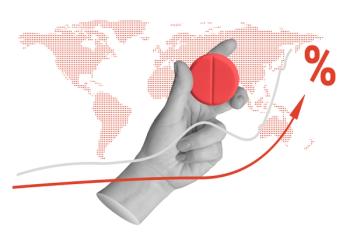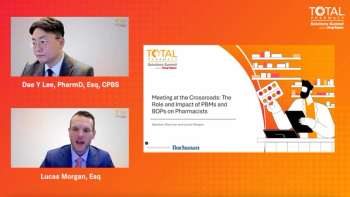
Drugs in the pipeline for diabetes
Not only are there effective antidiabetes treatments on the market, but drugs in development promise to expand patient options even further.
Not only are there effective antidiabetes treatments on the market, but drugs in development promise to expand patient options even further. Listed below are some current candidates.
In the pipeline
- Vildagliptin (Galvus), Novartis
Vildagliptin is an oral antidiabetic agent of the DPP-4 inhibitor class, administered once daily. It works by restoring the physiological balance between glucagon and insulin.
In February 2007, Novartis received an approvable letter from the Food & Drug Administration requesting additional information, which has delayed approval. The company estimates that a resubmission to the FDA for approval might occur mid-2009. The drug is already approved and available in Mexico and Brazil, and was approved by the European Union in September.
Rogelio Braceras, M.D., medical director, Novartis, told Drug Topics that clinical trials involving 8,500 patients, with over 6,500 treated with Vildagliptin, have shown A1c reductions of greater than 1% up to 1.8%. "We have data to prove its efficacy up to two years," said Braceras.
Data submitted to the FDA show Vildagliptin effective as monotherapy, in patients not in control with a TZD, and not in control with a sulfonylurea. "We even have data showing that when patients are not in control with insulin, adding vildagliptin to their regimen decreases A1c further, plus decreasing hypoglycemia in those patients," Braceras said. The drug has also been shown not to cause weight gain.
Braceras noted that clinical trials have included populations across the spectrum. "Part of our clinical program goal was to show that Vildagliptin is effective at any stage in the disease state, in different age groups, in different races, and in both the obese and non-obese."
- Liraglutide (trade name not yet announced), Novo Nordisk
Liraglutide, an incretin, is a modification of human GLP-1. The modification has been made for two reasons, according to Alan Moses, M.D., chief medical officer, North America, for Novo Nordisk. It has been made, first, "to decrease the natural degradation that occurs through the enzyme DPP-4; and second, to have it bind to serum albuminthe most abundant of the serum proteinsto prolong its half-life," explained Moses. Thus, the drug will be suitable for once-daily subcutaneous administration.
Phase II data show liraglutide to be efficacious as monotherapy for diabetes; a large phase III trial for monotherapy is under way, and results will be available in first quarter 2008. In addition, liraglutide has been found to improve glycemic control when used in combination with oral antidiabetic therapy, including metformin and a TZD. If trial results continue to come in as anticipated, the drug could be approved for use across the spectrum of Type 2 diabetes. The current phase III program does not include a combination with insulin, Moses said. "It might make sense, and one can assume that will be done later, although I can't comment specifically on that."
Phase II data support liraglutide's use fairly early in the course of the disease, according to Moses. "The mechanism of action of the incretin class would suggest that it's actually an ideal drug early in the disease, but that again remains to be seen from databoth with exenatide and with liraglutide," Moses remarked. A comparative trial with exenatide has just begun, so results will not be available for some time.
Like exenatide, liraglutide produces weight loss. It has a very low risk of hypoglycemia when used alone or with agents that themselves do not cause hypoglycemia. Its main side effects are gastrointestinal, and it is administered via a pen device. Differentiating it from exenatide is liraglutide's once-daily usage; plus, it can be taken at any time of the day, as long as it's the same time day to day. "It certainly lowers fasting blood glucose lower than exenatide," Moses added.
Novo Nordisk expects to submit liraglutide for approval to the FDA in 2008, with the hope that it will be approved during 2009.
- Saxagliptin (trade name not yet announced), AstraZeneca and Bristol-Myers Squibb
Saxagliptin, a DPP-4 inhibitor similar to sitagliptin (Januvia, Merck), is currently in phase III trials for once-a-day administration, either as monotherapy initial treatment for diabetes or in combination with metformin, thiazolidinediones, or sulfonylurea. Fred Fiedorek, M.D., VP of cardiovascular and metabolic global clinical research, Bristol-Myers Squibb, said, "We're going to be trying to understand whether it is different from sitagliptin or not. The underlying expectation is that it will be similar in terms of overall efficacy and safety profile."
Explaining why another DPP-4 could be useful, Fiedorek said, "There's a large need for patients with diabetes to have choices to treat their condition. The medicine they start with doesn't necessarily work more than a couple of years. They need additional medicines to get under control."
The goal, Fiedorek said, is to have data and be able to file for approval with the FDA the first half of 2008. If all goes well, the drug could be available to patients in 2009.
- Dapagliflozin (trade name not yet announced), AstraZeneca and Bristol-Myers Squibb
Dapagliflozin is a new-mechanism drug called an SGLT2 inhibitor, or sodium glucose cotransporter 2. It is being studied as a once-daily oral antidiabetic. Dapagliflozin allows the kidney to excrete glucose specifically, so it comes out in the urine and is not reabsorbed in the blood; thus, it does not contribute to the hyperglycemia that exists in diabetes.
Although glucose is normally filtered by the kidney, nearly all of it is reabsorbed in the proximal tubule by SGLT2, which is located almost exclusively in the kidney. For patients with diabetes, retention of excess glucose by this pathway contributes to persistent high blood glucose levels. Research in animal models indicates that modifying this glucose absorption with SGLT2 inhibition reduces blood glucose independent of insulin secretion or action. "So we're going to tell people that it's beneficial to lose sugar in their urine with dapagliflozin," Fiedorek said. "It's actually the kidneys acting as a spigot or release valve for glucose."
Because glucose represents calories, its release through the kidneys may help to improve a diabetes patient's problems with weight, Fiedorek added. "It's actually causing patients to lose calories when that glucose is released," said Fiedorek. Phase III trials, which are just beginning, will test not only improvements for blood sugar control but also participants' weight during the course of the trial. "If you calculate the amount of glucose loss that we've been seeing in the urine on a daily basis, it's thermodynamically equivalent to about the same caloric loss as if you spent 30 minutes a day on an exercise bike," explained Fiedorek. Another important feature of dapagliflozin, he said, is that it does not depend on insulin itself. "So we're excited about the possibilities of combining this medicine with existing diabetes medicines that do depend on either insulin release or insulin action."
It's too early to project FDA submission or approval dates for dapagliflozin, but industry reports show approval possible in 2010.
Peering into the crystal ball
Scientists continue to work in the obesity area along with diabetes control. "From a physiological perspective, there's no question that they're connected," Moses said.
Added Fiedorek, "What we're trying to doall of us in pharmaceutical companies and biotech companiesis develop treatments that will allow patients to have real choices to treat their disease. [Pipeline] drugs are going to be pieces of the armamentarium that doctors can use to treat diabetes. But treatment that will eventually reverse the disease completely is far off, I think."
THE AUTHOR is a writer based in New Hampshire.
Newsletter
Pharmacy practice is always changing. Stay ahead of the curve with the Drug Topics newsletter and get the latest drug information, industry trends, and patient care tips.










































































































































































































